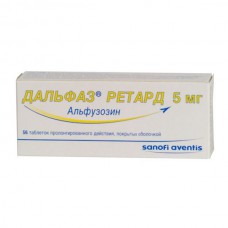Expiration date: 09/2026
Structure and Composition:
Dalfaz SR
The tablets of the prolonged action (sandwich) . One tablet contains:
first layer:
Valium 79.75 mg
Hydrogenated castor oil 13.5 mg
ethyl cellulose, May 20 mg
dye iron oxide yellow (E172) 0,25 mg
aqueous colloidal silica 0.5 mg
Magnesium stearate 1 mg
Second layer:
10 mg of alfuzosin hydrochloride
mannitol 10 mg
10 mg hypromellose
MSC 65 mg
3.2 mg Povidone
aqueous colloidal silica 1.25 mg
Magnesium stearate 1 mg
third layer:
114.01 mg of Valium
Hydrogenated castor oil 27.9 mg
povidone 4.72 mg
dye iron oxide yellow (E172) 0,15 mg
silica colloidal aqueous 1.05 mg
magnesium stearate 2.17 mg
in blisters of 10 pieces. a stack of cardboard packaging 1 or 3.
Dalfaz retard
Tablets, film-coated, sustained-release. One tablet contains:
5 mg of alfuzosin hydrochloride
Excipients: MCC - 42 mg calcium hydrogen phosphate dihydrate - 65 mg Hydrogenated castor oil - 19.6 mg Povidone - 7 mg Magnesium stearate - 1.4 mg
Uncoated tablet weight - 140 mg
composition of film-coating: hypromellose - 4,158 mg of propylene glycol - 0.416 mg of titanium dioxide (E171) - 0,416 mg of iron oxide red dye (E172) - 0.1765 g, and color iron oxide yellow (E172) - 9.8235 g (as a suspension)
In the film-coated tablets, weight - 145 mg
in blister 14 pcs. in box 4 of the blister.
Description pharmaceutical form:
Tablets, sustained-release (SR Dalfaz): round biconvex three-layer tablets, one white layer between two yellow layers with different color intensity. Valid blotches.
Tablets, film-coated, sustained-release (retard Dalfaz): round biconvex tablets, film-coated, pale yellow color.
Pharmacokinetics:
The average value of the relative bioavailability of CP Dalfaza 104.4% compared to an immediate release form (2.5 mg twice a day) in healthy middle-aged volunteers. Cmax achieved after 9 hours (Dalfaz SR), 3 hours (Dalfaz retard) after oral administration. T1 / 2 is 9.1 hours (Dalfaz SR), 8 hours (Dalfaz retard). Bioavailability retard tablets is about 15% less compared to the 2.5 mg alfuzosin. Food intake has no effect on the pharmacokinetic profile of the drug (Dalfaz retard). Studies have shown that consistent pharmacokinetic curves are obtained by taking the drug after meals (Dalfaz SR).
Compared with patients with normal function of T1 / 2 is not kidney unchanged, and the mean values ??Cmax and AUC in patients with renal insufficiency moderately increased. These changes in the pharmacokinetic profile of the drug (Dalfaz SR) are not clinically significant and do not require dose adjustments.
Binding to plasma proteins - about 90%.
Alfuzosin undergoes considerable metabolism in the liver, mainly by of CYP3A4, only 11% of the drug in unchanged form excreted in the urine. Metabolites not possess pharmacological activity. Most of the metabolites excreted in the feces (75-90%).
Pharmacokinetics in special patient groups (Dalfaz retard)
Persons older than 75 years of absorption is faster and higher Cmax. Some patients may increase the bioavailability of the drug and decrease the volume of distribution. T1 / 2 is not changed.
In patients with severely impaired hepatic function of elimination increases T1 / 2 and bioavailability as compared to healthy volunteers.
In patients with impaired renal function, requiring not require dialysis, due to the increase in the free fraction of the drug (Dalfaz retard) the volume of distribution and clearance of alfuzosin are increased.
In chronic heart failure the pharmacokinetic profile of alfuzosin is not changed.
Description of the pharmacological actions:
Alfuzosin is a quinazoline derivative, active when administered orally.
It is a selective antagonist of postsynaptic alpha-1-adrenergic receptors located in the prostate, bladder triangle and the urethra.
Clinical symptoms of benign prostatic hypertrophy expressed in urinary bladder outlet obstruction associated with both anatomical (static) and functional (dynamic) factors. The functional component of obstruction caused by the excitation of alpha1-adrenoceptor leads to a reduction in smooth muscle of prostate and its shell, the triangle of the bladder and prostatic urethra, resulting in increased resistance to the outflow of urine from the bladder instability secondary to bladder.
Due to the direct effect on the smooth muscles of the prostate tissue associated with alpha1-adrenoceptor blockade, alfuzosin reduces bladder outlet obstruction, the pressure in the urethra, and the resistance of the flow of urine during urination. Due to this, alfuzosin improves urine flow and facilitates bladder emptying. These favorable effects on urodynamics lead to a reduction in symptoms of irritation and urinary tract symptoms due to impaired flow of urine in patients with benign prostatic hyperplasia. In patients with a maximum rate of urine flow (Qmax) & le15 ml / sec alfuzosin, beginning with the first dose, significantly increases Qmax (an average of 30%). Also in patients with benign prostatic hypertrophy alfuzosin significantly reduces the pressure in the bladder detrusor and increase the volume of urine causing the urge to urinate, and significantly reduces the amount of residual urine.
Due to its selective action alfuzosin effect on alpha1-adrenergic receptors and vessels, respectively, in blood pressure when used in therapeutic doses is practically absent.
Indications:
For both drugs: treatment of functional symptoms of benign prostatic hyperplasia.
Dalfaz SR
In addition - as an adjunct to using the catheter for acute urinary retention associated with benign prostatic hyperplasia.
Contraindications:
- Hypersensitivity to alfuzosin and / or other ingredients
- orthostatic hypotension
- severe liver function abnormalities (class C Child-Pugh classification)
- severe renal impairment (Cl creatinine <30 ml / min)
- ileus (due to the presence of castor oil formulation)
- concomitant use of other alpha1-blockers.
Dalfaz retard
Carefully:
Patients receiving antihypertensive drugs
Elderly patients
Patients with indications of hypotonic reaction to alpha 1-blockers
patients with symptomatic orthostatic hypotension (possibility of orthostatic hypotension)
Patients with coronary artery disease, angina (possibility of more frequent and worsening of angina attacks)
patients with symptomatic and asymptomatic manifestations of coronary artery disease of the brain (risk of cerebral ischemia on the background of hypotension).
Side effect:
Dalfaz SR
The following undesirable effects are based on the following gradations their frequency of occurrence: very common - often & GE10% - & ge1- <10% infrequently - & ge0,1- <1% of rare - & ge0,01- <0,1% very seldom - < 0.01%, including isolated cases.
On the part of the central nervous system and psyche: often - fatigue, feeling of general discomfort, headache, rarely - drowsiness, dizziness, cerebral ischaemia (in patients with coronary artery disease of the brain).
From the CCC: rarely - tachycardia, palpitations, syncope, orthostatic hypotension, very rarely - angina pectoris in patients with coronary artery disease, atrial fibrillation.
On the part of the digestive tract: often - nausea, abdominal pain, dry mouth, rarely - very rarely diarrhea - damaged hepatocytes, liver disease with cholestasis.
Skin and allergic reactions: seldom - rash, itching, very rarely - urticaria, angioedema.
On the part of the whole body: often - fatigue rarely - skin redness, edema, chest pain, rarely - priapism.
Dalfaz retard
The following undesirable effects are based on the following gradations their frequency of occurrence: very common - often & GE10% - & ge1- <10% infrequently - & ge0,1- <1% of rare - & ge0,01- <0,1% very seldom - < 0.01%, including isolated cases.
On the part of the central nervous system and psyche: often - fatigue, dizziness, feeling of general discomfort, headache, rarely - drowsiness, cerebral ischaemia (in patients with coronary artery disease of the brain).
On the part of the organs of vision: rarely - visual impairment.
From the CCC: often - hypotension (orthostatic) rarely - tachycardia, palpitations, fainting, very rarely - angina pectoris in patients with coronary artery disease, atrial fibrillation.
From the respiratory system: rarely - rhinitis.
On the part of the digestive tract: often - nausea, stomach pain, diarrhea, dry mouth, rarely - damage to hepatocytes, liver disease with cholestasis.
Skin and allergic reactions: seldom - rash, itching, very rarely - urticaria, angioedema.
On the part of the whole body: often - fatigue rarely - skin redness, edema, chest pain, rarely - priapism.
Drug Interactions:
Contraindicated combinations:
- Alpha1-adrenergic blockers (prazosin, urapidil) - risk of severe orthostatic hypotension and increased hypotensive effect (see "Contraindications" section.).
Interactions to be taken into account (for both drugs):
- Antihypertensive drugs, including BPC - increased antihypertensive effect and risk of orthostatic hypotension (additive effect) (see "Special Instructions" section.)
- Inhibitors of CYP3A4 (ketoconazole, itraconazole and ritonavir) - alfuzosin may increase the concentration (in combination with ketoconazole increases in Cmax alfuzosin 2.1-2.3 times).
Dalfaz retard
Additionally:
- Nitrates - increased risk of reflex tachycardia and decrease of blood pressure
- Means for anesthesia - possible instability of blood pressure during anesthesia.
Dosage and administration:
Dalfaz SR
Inside, after eating, swallowing whole, 10 mg daily.
The use as an aid when using a catheter in acute urinary retention related to benign prostatic hyperplasia: The recommended dose - 1 tab. 10 mg a day, after meals, starting with the first day of catheterization. The drug used for 3-4 days, i.e. 2-3 days in the application of the catheter and one day after its removal.
Dalfaz retard
Inside, swallowing whole, washed down with a glass of water about 1, 1 table. (5 mg), 2 times a day (morning and evening).
Adults: The recommended dose - 1 tab. (5 mg), 2 times a day (morning and evening).
Elderly patients and / or patients with hypertension receiving antihypertensives
As a precautionary measure, the appointment of alfuzosin these categories of patients is recommended to start treatment with 1 tablet. (5 mg) in the evening, increasing the dose according to clinical response, but without exceeding the dose - Table 1. 2 times a day.
Patients with renal failure
When Cl creatinine more than 30 ml / min, a correction mode is not required.
Patients with hepatic insufficiency
Note elongation T1 / 2 preparation and the possibility of increasing its bioavailability, therefore, treatment should begin with a dose of 2.5 mg 1 time per day, which may increase depending on the clinical response, but should not exceed 2.5 mg two times a day.
Tablets can not crush, grind, milled or comminuted to a powder state, because violation of the tablet structure may lead to an acceleration of the absorption of the active ingredient, which may contribute to the development of side effects.
Overdose:
Symptoms: hypotension, reflex tachycardia.
Treatment: hospitalization, continuous blood pressure monitoring. If blood pressure reduction is recommended the introduction of a vasoconstrictor and plasma expanders (to increase bcc). After the restoration of blood pressure (hypotension eliminate) its monitoring should be carried out for at least another day.
Hemodialysis is not effective (because of the high degree of binding to plasma proteins alfuzosin).
Special instructions:
In some individuals, particularly in patients receiving antihypertensive medications, within a few hours after taking alfuzosin (and after taking other alpha1-blockers) may develop orthostatic hypotension with clinical symptoms (dizziness, severe weakness, cold sweat) or without . Orthostatic hypotension is usually transient and there is usually at the beginning of the drug, and usually does not require discontinuation of treatment. When these phenomena must be patient until their complete disappearance in a horizontal position. Before treatment, the patient should be warned of the possibility of such phenomena.
Caution must be exercised in the appointment of alfuzosin in patients with orthostatic hypotension with clinical symptoms, patients with a history of instructions expressed hypotensive response in response to treatment with other alpha1-blockers - requires a careful control of blood pressure, including the transition from horizontal to vertical position, especially at the beginning of treatment.
In patients with coronary artery disease antianginal therapy should be continued. Upon renewal or worsening angina treatment alfuzosin should be discontinued.
Effects on ability to drive and work with mehanizmami.Osobenno at the beginning of treatment should take into account the possibility of dizziness, asthenic conditions that may affect the ability to drive vehicles and operate machinery.



